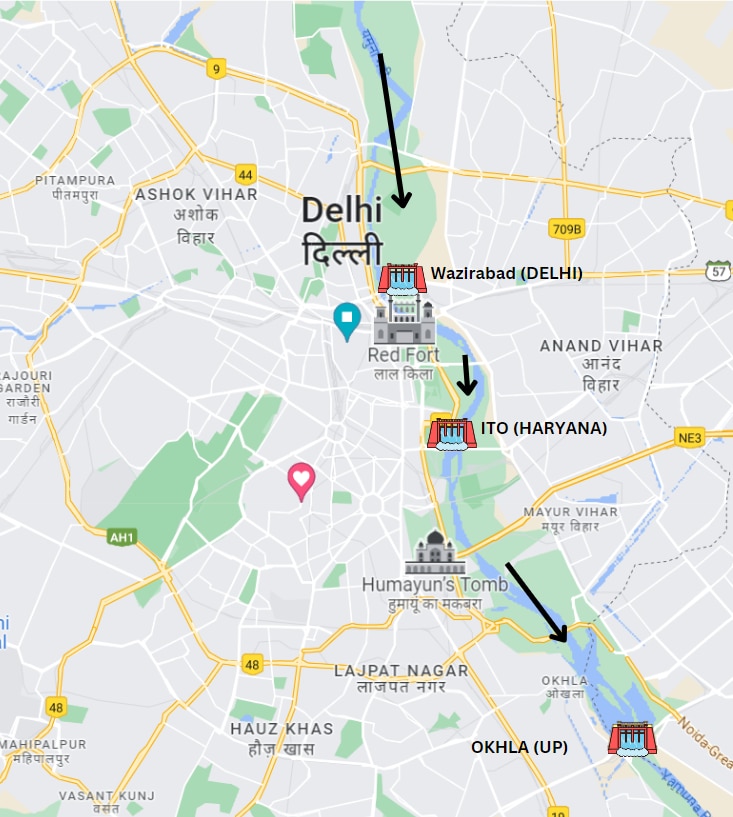Yamuna has 3 barrages, managed by 3 states. Did that worsen the Delhi floods?

The ITO barrage also serves as a bridge connecting Central Delhi to the East. (Photo: Himanshu Sharma, India Today)
This year's monsoon in Delhi brought unprecedented inundation, wreaking havoc in various parts of the capital. As the floods hit, the blame game ensued among different governments and parties, each attempting to shift responsibility for the urban floods on each other.
One significant factor exacerbating the floods is the mismanagement and disregard for the barrages constructed along the mighty Yamuna River in the city-state.
Delhi's three barrages
- The Yamuna River stretches for 1376 km, with just 22 km of its course flowing through Delhi.
- Along this short stretch, three barrages were built to regulate the river's flow: the Wazirabad Dam, the ITO Dam, and the Okhla Dam. Surprisingly, each dam is managed by a different state government - Delhi, Haryana, and Uttar Pradesh, respectively.

- Surprisingly, each dam is managed by a different state government – Delhi, Haryana, and Uttar Pradesh, respectively.
- The primary purpose of these dams is to regulate the flow of the Yamuna, not to store water.
The recent floods exposed a glaring issue with the maintenance of the barrages.
ITO barrage
- The ITO barrage, which came up in the mid-60s managed by the Haryana Government, encountered significant issues during the floods.
- No maintenance of the barrage led to the failure to lift 5 of the 32 gates due to jamming and corrosion which eventually resulted in water backing up.
VIDEO | "We have identified 5 gates of ITO barrage, which is maintained by the Haryana government, that are jam. Lot of water which is coming into Delhi from Wazirabad side is not getting released from ITO (barrage) causing rise in water level," says Delhi minister Saurabh… pic.twitter.com/C9y00ulkm3
— Press Trust of India (@PTI_News) July 13, 2023
- Originally built to supply water to the Indraprastha power plant, as most of the power from the plant used to light up fields and houses in Punjab/Haryana, the ownership of the dam was later transferred to Haryana after Punjab's bifurcation.
- Unfortunately, the Haryana government PSU stopped funding the dam's maintenance, and Delhi's government failed to take responsibility, neglecting essential upkeep.
- The Army engineers were roped in to remove the 5 jammed and dysfunctional gates, while the Navy divers dived into the Yamuna and dug out the silt and garbage that had accumulated because of no de-silting of the barrage for a long time.
- The Okhla Dam, under the responsibility of the Uttar Pradesh state government, also faces its share of challenges in maintaining effective flood control measures. But in this case, it didn't contribute too much.
Interesting: Haryana CM @mlkhattar sets up 2 member fact finding committee to look into the jammed gates of the ITO barrage in Delhi that led to much flooding.. yesterday on my show a Delhi BJP leader claimed that Haryana had nothing to do with ITO barrage and Delhi AAP govt must…
— Rajdeep Sardesai (@sardesairajdeep) July 15, 2023
The blame game between governments intensified following the floods. The Delhi government pointed fingers at the Yamuna breaching the 1978 mark, while the Haryana government faced criticism for discharging enormous volumes of water towards Delhi, disregarding the improper maintenance of the ITO Dam.
The lack of ownership and responsibility from both sides resulted in inadequate preparedness for the floods.
Role of Delhi Jal Board and Municipal Corporation of Delhi (MCD)
Aside from the barrage mismanagement, the floods were worsened by the unclean and clogged drainage systems in various areas of Delhi.
- The Delhi Jal Board and Municipal Corporation of Delhi, under the control of the Delhi government, were responsible for maintaining these drainage systems. However, their failure to clean the drains on time before the monsoon led to waterlogging in areas far away from the Yamuna.
5-km long Seelampur drain in Delhi runs through 5 wards with a population of 3 lakh people. It was last cleaned before MCD elections.
— Priti Gandhi - प्रीति गांधी (@MrsGandhi) January 20, 2023
Complaints to officials have got responses like, "oath taking is not complete & budget has not been allotted."
This is Kejriwal's Delhi Model!! pic.twitter.com/9ZgFvzUytr
- Gates of a few drains discharging into Yamuna also malfunctioned and couldn't stop the water from flowing back into the city's streets.
The floods in Delhi could have been significantly mitigated through collaborative efforts among the concerned governments and bodies. Proper maintenance of dams, timely cleaning of drainage systems, and effective flood management strategies are crucial to address the challenges posed by heavy monsoon rains.
As the impacts of climate change become more evident, governments need to prioritise flood management and disaster preparedness to safeguard their citizens and urban infrastructure.

